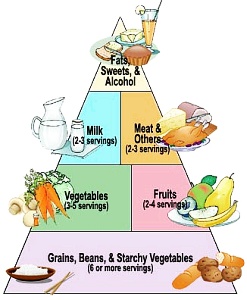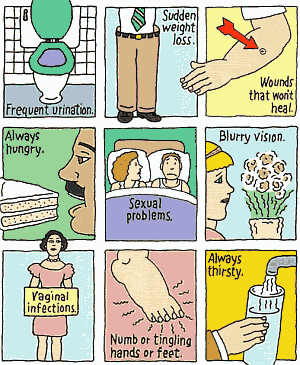 Article by Dalia Ghoneim for Biomed Middle East
Article by Dalia Ghoneim for Biomed Middle East
All of us love food and most of us have gone through a diet regimen, but have you ever been on a lifetime diet plan?!! Unfortunately that’s what 171 million people, almost 2.8% of the population (as of 2000) suffer from on a daily basis they have to watch what they eat and keep track of any food stuff that enters their bodies.
These people suffer form a condition known as diabetes mellitus in which their bodies lack the ability to either produce enough or does not properly respond to insulin which is a hormone produced in the pancreas. Insulin enables cells to absorb glucose in order to turn it into energy and as the end result of most of the food entering our bodies is glucose; this causes glucose to accumulate in the blood, leading to various potential complications. Diabetes is a serious condition and should not be regarded as a minor disease as the accumulation of glucose in blood may lead to several damages to other organs. According to recent number diabetes is the leading cause of kidney failure, blindness, and amputation in adults. If untreated, diabetes does lead to reduced life expectancy.
Actually, there are many kinds of diabetes but the most known are these two types:
Type 1: (juvenile diabetes or Insulin-dependent diabetes mellitus (IDDM)) this type results from the body’s failure to produce insulin.
Type 2: (maturity onset diabetes or non-insulin dependent diabetes mellitus (NIDDM)) which results from insulin resistance, a condition in which cells fail to use insulin properly, sometimes combined with absolute insulin deficiency. Most people who are diagnosed with diabetes have type 2 diabetes. This does not usually occur until after the age of 40 although 2 to 5% of those people affected do get diabetes type 2 before they are 25 years old.

Causes
So what causes this medical condition????!!! Although diabetes as a disease was recognized since middle ages, the exact cause of it is still unknown to us. The pathogenesis was clearly known since the 1900, but what exactly triggers diabetes is still a mystery and requires further experimentation and studies.
It is of importance to mention that both types of diabetes tend to run in families and genetic factors do contribute to the disease. But it also must be recognized that genetic contribution is not enough and that environmental factors play a significant role, as they are considered to stimulate the appearance of the disease. One proof of this is identical twins. Identical twins have identical genes, yet when one twin is diagnosed with diabetes the other one doesn’t necessarily get the disease.
Besides inheritance, the only logical explanation of Diabetes mellitus type 1 is that it is an autoimmune disease, in which the body starts destruction of its own beta cells which produce insulin . This explanation depends on the fact that most people who develop type 1 are otherwise healthy.
There are numerous theories as to the exact cause of type 2 diabetes. One of these theories correlates Type 2 diabetes with obesity depending on the fact that obesity is found in approximately 55% of patients diagnosed with type 2 diabetes. Also it was noticed that in the last decade, type 2 diabetes has affected more children and adolescents than it used before, probably in connection with the increased prevalence of childhood obesity. It is believed that insulin resistance increases because of the loss of lean tissue and the accumulation of fat, particularly intra-abdominal fat.
Also another theory states that glucose tolerance progressively declines with age, leading to a high prevalence of type 2 diabetes in the older population. This is due to the fact that circulating insulin levels where found to be similar to those of younger people but the problem relays in the mechanism of binding the insulin to the glucose.
Some medical conditions such as Cushing’s syndrome (cortisol excess), hypogonadism, testosterone deficiency may be the underlying cause of DM type 2.
Symptoms
 Although DM is a serious condition it has very vague symptoms and they mostly go by unnoticed by the patient. The classical symptoms of DM are polyuria, polydipsia (increased thirst) and polyphagia (increased hunger). Type 1 diabetes may also cause a rapid yet significant weight loss, despite normal or even increased eating, and irreducible mental fatigue.
Although DM is a serious condition it has very vague symptoms and they mostly go by unnoticed by the patient. The classical symptoms of DM are polyuria, polydipsia (increased thirst) and polyphagia (increased hunger). Type 1 diabetes may also cause a rapid yet significant weight loss, despite normal or even increased eating, and irreducible mental fatigue.
The symptoms usually develop quite rapidly in type 1 diabetes, particularly in children, and here comes the role of the parents where they should closely monitor their children for any change in their eating or drinking habits. However, in type 2 diabetes symptoms usually develop much more slowly and may be subtle or completely absent.
Diagnosis
So if anyone develops these symptoms DM is suspected and the final diagnosis is made by measuring the blood glucose concentration. Diabetes mellitus is characterized by recurrent or persistent hyperglycemia, and is diagnosed by demonstrating any one of the following:
• Fasting plasma glucose level at or above 7.0 mmol/L (126 mg/dL).
• Plasma glucose at or above 11.1 mmol/L (200 mg/dL) two hours after a 75 g oral glucose load as in a glucose tolerance test.
• Symptoms of hyperglycemia and casual plasma glucose at or above 11.1 mmol/L (200 mg/dL).
Treatment
As soon as diabetes is diagnosed treatment should be started immediately. Diabetes was considered fatal until insulin became medically available in 1921, since then all forms of diabetes have been treatable but until now not a final cure has been found for any type of diabetes.
Insulin is considered a treatment for both type 1 and type 2 diabetes. The difference is relays in the fact that type 1 diabetes is fatal unless treated with insulin due to the lack of the hormone from the body, but type 2 can be treated with other oral drugs which act through different mechanisms either by increasing tissue sensitivity to insulin, or increasing the rate of glucose consumption by the body which eventually leads to lower glucose blood level
Injection is the most common method of administering insulin; insulin pumps and inhaled insulin has been available at various times. Pancreas transplants have been suggested to treat type 1 diabetes however it is still in experimental trials.
Besides medication an important aspect in controlling diabetes is lifestyle modifications. These modifications include consuming an appropriate diet, sensible exercise, quitting smoking with the goal of keeping both short-term and long-term blood glucose levels within acceptable bounds.
Here comes the role of patient awareness and patient education, where diabetic patients must be clearly aware that eating a balanced diet and taking regular exercise is a key factor in controlling their medical condition. Patients must fully understand that testing blood sugar regularly is essential in monitoring and keeping blood sugar levels within appropriate levels.
Diabetes should be approached as a harsh condition and considered as an enormous personal problem that is affecting hundreds of millions of people worldwide. Based on the nature of the disease public awareness should be recognized as the first step in the path of controlling diabetes.
We must face the fact that according to the latest statistics by the year 2025 the world population will reach 8 billion of which about 300 million will suffer from diabetes, considering the size of this number an action must be taken.

Thx for your excellent article. Very informative. Finding a cure through medication would be helpful, but as you know, a lot could be done by all of us thru proper diet and exercise. Self discipline however can be tough. But if circumstances exist whereby medication is needed, I wanted to possible help some people out there by letting them
know about a site that few people know about, but can help greatly in paying less for all their medications, diabetes
included. I have known as least 10 people it has helped, some diabetic, some with other prescriptions they get, and hopefully this will help get the word out. The site is http://www.medpap.ws and tho it’s “free,” the “catch” is that they want you in their store hoping you will impulse shop and pick up other items while you are there. One of the oldest marketing ploys in the world, but if you can just use the card….enjoy the savings, and don’t buy anything else you don’t truly need, you will beat the system. There also is a short 1 minute video to explain how it works. It is a good program that saves you money so I hope u take advantage of it. Take care and hopefully great health will be a reality for all of us one day.
As a Type 2 diabetic of about 9 years I can say that this is a good article. Getting diabetes is something that you want to avoid, because despite the spam and “get rid of diabetes” books I don’t believe that you can every do any better than control it. This takes constant attention to your food and exercise plan. I think you could add more on exercise, as it seems to me, from experience, that more muscle quantity and strength helps control the problem. This means, that besides weight-loss exercises, you should put resistance exercises into your routine.
By the way your graphic/cartoon is fabulous. Although I have read many articles I haven’t seen such a good graphic before. It is very very helpful and should be more widespread. In my opinion it could be further improved by some simple refinements. The first would be to change the “vaginal infections” to “skin fungal infections” as these are much more widespread than just vaginal infections. Even though my diabetes is under control I still often get fungal infections. The second modification is that I would change the “numb or tingling hands or feet” to also be broader by saying “tingling or aching hands or lower legs and feet”. It’s more in the aches and tingles in the lower legs and feet that people seem to notice. I guess hands are there also but I don’t usually hear people mention their hands before they mention the bottom of their legs of feet.
With those changes I think it would be really great education poster, especially for middle-aged and older people.
Walter Adamson